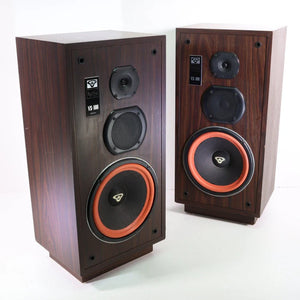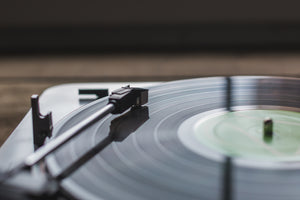We are unable to reply to comments, so please message us directly if you have a specific question regarding products, shipping costs, etc. Our office number is (480) 207-1511. Our email is hello@spencertified.com. You can also message us on Facebook. Commonly asked questions and answers can be found on our FAQs page here.

THE DIFFERENCE BETWEEN ANALOG AND DIGITAL MEDIA
DID THE DIGITAL REVOLUTION KILL OLD-SCHOOL ANALOG MEDIA?
Our current world lives and breathes digital media - in fact, you’re probably reading this on a smartphone, tablet, or computer right now. It’s such an ingrained part of our lives that most of us don’t think twice about the term “digital” or what it actually means.
But in the world of vintage audio and video gear, there is one other opponent that’s still attempting to run this technological race. The tortoise to the digital’s hare, so to speak. Its name? Analog.
Yet what exactly is analog media? How does it differ from digital media? Is analog media dead? We get great questions like these quite often, which is understandable! In our world of ever-emerging new technology, it can get complicated keeping everything straight. That’s why we’re here to break it all down for you.
WHAT IS ANALOG MEDIA?

Analog media uses continuously varying electrical or magnetic fields to store data. Using voltage, resistance, rotation, or pressure, analog machines and analog media measure, record, and playback audio and image information. Its output is similar to its input.
In other words, it is media that doesn’t have to be translated using code before you can use it. Instead, the data is recorded and played linearly from one point to another. Analog devices physically read data from the piece of analog media to play it back.
Examples: Vinyl records, cassettes, VHS tapes, typewriters, analog radios, and printed pictures.
Fun Fact! Analog or “analogue” wasn’t used as a technical term until the 1940s, when it referred to a class of computing technology.
WHAT IS DIGITAL MEDIA?

Digital media needs to be stored and coded digitally. It uses a series of zeroes and ones (binary code) to record, store, and playback media. In essence, it’s any form of media that needs an electronic device to be created, stored, viewed, and distributed. Most of today’s technology uses digital media.
Examples: DVDs, CDs, Blu-rays, smartphones, online pictures, thumb drives, and digital downloads.
WHAT’S THE DIFFERENCE?

In short, the difference between the two is this: analog is the opposite of digital. Simple, right?
Well, to be more specific, digital media requires a “middle man” (binary code) whereas analog media does not. Instead, analog is anything that doesn’t need to be translated into binary code to be viewed or played; it’s basically stored the same as it actually is.
The difference is perhaps easiest to understand using examples. Vinyl, for instance, is the perfect example of analog media. Records are sound made solid - by etching sound waves into plastic, then scratching a needle along those waves to create vibrations, you get the same sound waves you had at the beginning. The only difference is they were amplified to an audible level.
CDs, on the other hand, use a binary code of numbers. When a song is recorded onto a CD, a laser etches a code of pits and lands onto the disc. Then when it’s played, the CD player’s laser decodes these lands as 1s and pits as 0s. As the laser moves around the disc, the binary code is read and converted back into electrical signals, which is then amplified through speakers.
IS ANALOG DEAD?

The Digital Revolution began around the 1960s and 70s. This was when the movement from analog to digital started to hit its stride. During this time, digital technology made its way into the homes of everyday consumers, changing the way we communicate and how we interact with media.
In the process, devices like analog radios, fax machines, compact cassettes, and VHS tapes became closer to esoteric antiques than the automatic go-to. But they’re not dead. The recent vinyl resurgence has brought back a love for the vintage; boomboxes, cassette tapes, and records have all made a comeback.
Yet this resurgence didn’t resurrect analog or bring it back from the dead. Old analog media has always lived on in the homes of audiophiles, audio enthusiasts, and hard-core music lovers. Why? Well, some inherit these machines and media from family. But for many, it’s because analog as a whole wins the race over digital.
Digital certainly has its benefits - improved response times, storage, communication, and convenience - but analog has its place. Analog media can produce a warmer, more natural sound that many find pleasing to the ear. They’re also more tangible and satisfying to play. Plus, vintage is, well, cool - at least in our opinion. Vintage media reminds us of a time gone by and gives us that touch of nostalgia that makes digital playlists and streaming feel detached by comparison.
SUMMARY
Even in our current world of digital media, analog lives on. The Digital Revolution certainly shot out into the technological world like a rabbit, but it's the analog that has stayed slow and steady in our hearts. It’s not out of the running yet.
We here at SpenCertified are dedicated to making sure analog media remains just as playable as digital media. So if you’re in need of an analog player for reels, 8-tracks, cassette tapes, vinyl records, or VHS tapes, you can check out everything we have available here. Thanks for reading! Have a great day.


Leave a comment